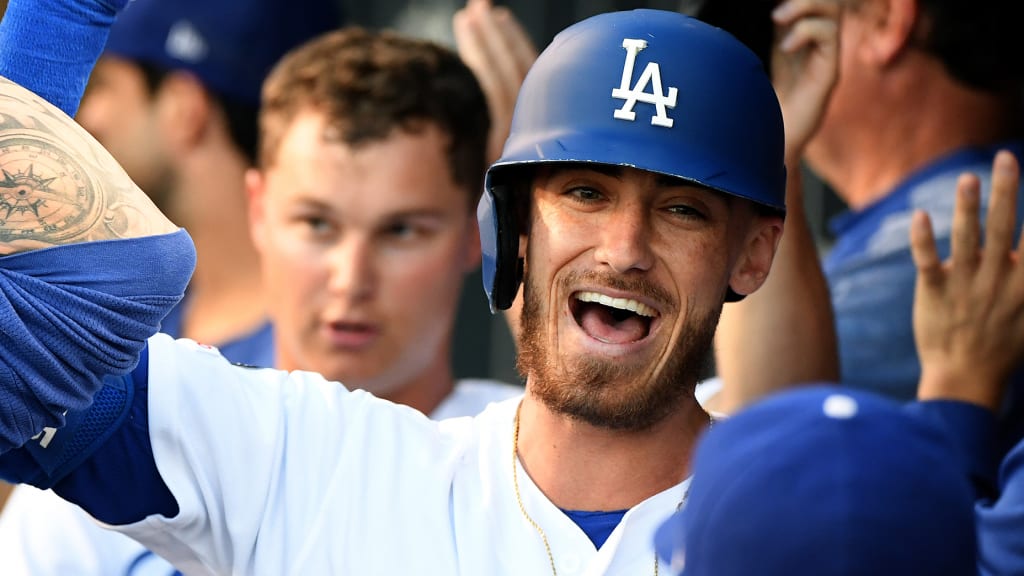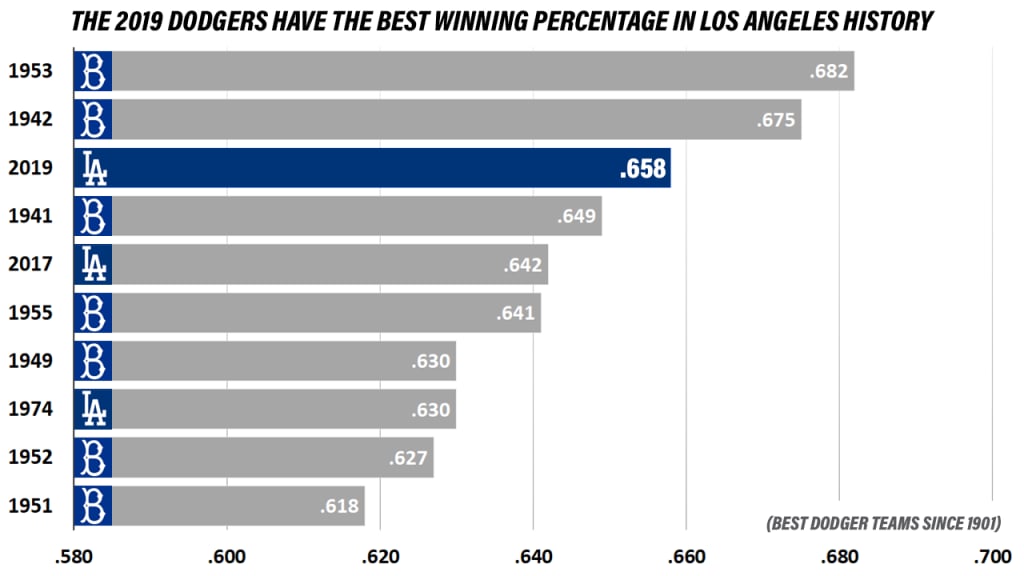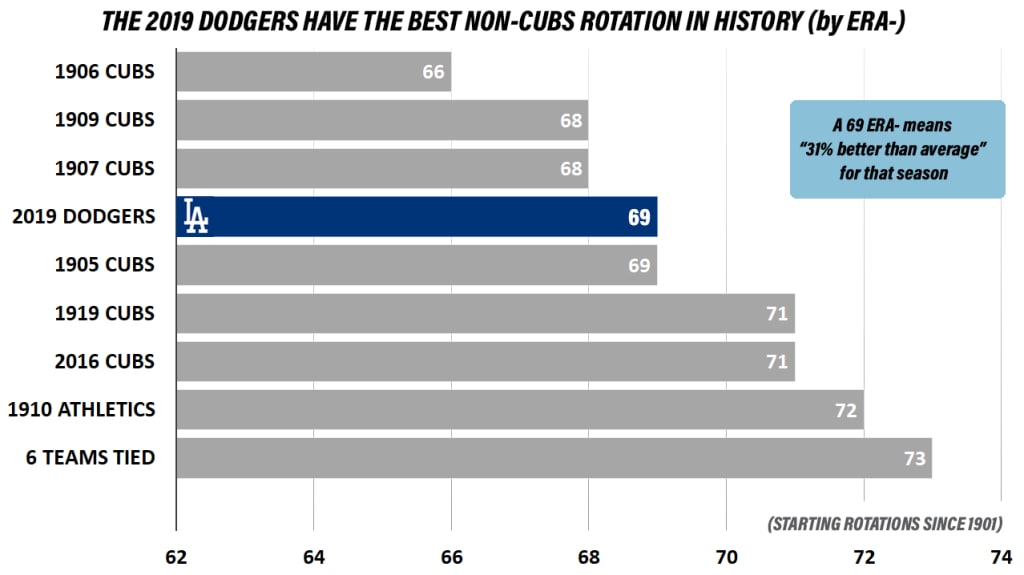
The Dodgers are having a great season, because it seems like the Dodgers of recent vintage always have a great season. They're about to win their seventh consecutive National League West title. They've enjoyed a lead of at least five games for months, since the middle of May. Since the beginning of their run back in 2013, not only do they have the most wins in the Majors (644), they have a full 28 more than second-place Cleveland.
The Dodgers have scored the most runs in the National League. They've allowed the fewest runs in baseball. They have the best defense in baseball, by one metric, and their hitters have been the second most clutch in baseball by another. They're openly treating the rest of the season as a tryout camp for October, because why not? "The Dodgers are good" is not exactly news.
But this... this is something else. Despite the fact that they've gone to the World Series in each of the last two seasons -- and yes, Dodger fans, lost twice, we know -- the 2019 collection might be the best of this entire seven-year stretch. We can say that because it's the best Dodgers team in Los Angeles history. If you're under 70 years old, it's the best Dodger team most people alive have ever seen.
You can get to that simply by looking at their .658 winning percentage, which is currently the third-best in Dodger history behind only the 1942 Brooklyn team of Pete Reiser and Dolph Camilli and the famed 1953 Brooklyn club of Jackie Robinson, Duke Snider, and Roy Campanella. It's better than the 2013 team that had a 42-8 run. It's better than the 2017 team that tore off a 43-7 run. Unlike those teams, there's been no down period. The worst month the 2019 club has had was July... when they went 14-10.

(All due respect to the 1899 Brooklyn Superbas and the 1889 Brooklyn Bridegrooms, who had Bob Caruthers throw 445 innings, we're going back only to 1901 here, as it's the birth of the American League and the "modern era" of baseball.)
You don't get to be that good -- and they are that good -- without a whole bunch of things going right. There's way more than four of them, but, here are four of them.
1) The rotation might be the best non-Cubs group ever ... sort of.
Here's how talented the 2019 Dodger starting rotation is: Clayton Kershaw is the best pitcher of his generation and one of the best who ever lived, and at age 31 he's having a typically strong season. If he's not quite as dominant as he was when he was winning the MVP Award back in 2014, he's still got a 2.77 ERA, and he still made the All-Star team, his eighth. (And an 11-2 record, if you care about such things.) He's still very good.
He might also only be the third-best Dodger starting pitcher right now. That's how good Hyun-Jin Ryu, who is having one of the most magical seasons on record thanks to his 1.45 ERA, has been. That's how good Walker Buehler, who has a higher strikeout rate and a lower walk rate than Kershaw -- and a nearly 10-to-1 strikeout-to-walk rate since May 1 -- has been.
When the great Kershaw, still one of the better pitchers in the game, might not even be one of your top two starters, then you know you've got something special, and the Dodgers do. It's one thing to say that they lead the Majors in ERA both from their rotation (2.90) and overall (3.32), because they do. They have the lowest walk rate (6.3%), the best hard-hit rate (31.7%), and the best Statcast quality-of-contact metrics (.281 xwOBA).
But it's another thing to try to put that into a historical context, because the game has changed so much over the years, and we don't have Statcast data before 2015. One way to do that is with ERA minus (ERA-), which asks a simple question: How much better was this player or team than the league average for that season? (It's like OPS+, but for pitchers.)
Throw in small adjustments for park effects, and you have your answer. The 2019 Dodgers starting rotation and their 2.90 ERA have a 69 ERA-, making them 31% better than the 2019 average ... which is one of the best marks ever, behind only some ancient Cubs teams and just ahead of the 2016 curse-breakers.

If you prefer looking at something like Fielding Independent Pitching, which doesn't worry about run scoring so much as it does strikeouts, walks, and home runs, then the Dodgers rotation is tied for sixth-best ever.
So, why the qualifier of "sort of?" Because starters don't function in the same way that they used to. The 2019 Dodgers will end up with something like 900 innings from their starting rotation. The 1906 Cubs, even in a shorter season, threw 1,388 1/3 innings. That's why the 2019 Dodgers won't rate as well in a counting stat like Wins Above Replacement. Then again, the 1906 Cubs didn't exactly have to face Christian Yelich and Ronald Acuña Jr., did they? On a rate basis, this group has performed just about as well as they could.
2) The lineup has depth. So much depth.
Last week, we wrote about how the 2019 Yankees were getting past their never-ending run of injuries by running out second- and third-string players -- unlikely names like Mike Tauchman and Gio Urshela -- who were productive, meaning that a mere 6% of plate appearances were given to batters with an OPS+ below 90, where 100 is league average. That's another way of saying: If you don't play unproductive players, you'll do well. Of course.
As you'll see from the chart included in that piece, the team with the next-lowest rate of plate appearances given to unproductive players is ... the Dodgers.
Impressive though that might be, it also might be somewhat underselling it. Right now, the Dodgers have 13 batters with at least 100 plate appearances. Eleven of them, from Cody Bellinger and Max Muncy down to Matt Beaty and David Freese, meet our "productive" threshold of having an OPS+ of 90 or above.
The only two that don't are catchers Austin Barnes (63 OPS+) and Russell Martin (84 OPS+). Of course, that's not the current state of the backstop position, because Barnes has spent the last few weeks in Triple-A. In his place, rookie catcher Will Smith is hitting a mere .313/.360/.746. On days Smith starts, which these days is "most days," the Dodgers haven't had a single unproductive hitter in the lineup.
Meanwhile, lurking in Triple-A: No. 10 overall prospect Gavin Lux, who is hitting .441/.524/.811 -- no, seriously -- for Oklahoma City, and who will likely join the Dodgers at some point this season.
3) The bullpen might, too.
When the Dodgers failed to make any moves for a big-ticket reliever at the deadline -- Adam Kolarek is nice, but he's not exactly Felipe Vázquez -- it wasn't exactly received well by local fans and some media. That's understandable to a certain extent, although the performance of traded relievers on new clubs hasn't quite been stellar yet.
That's because Kenley Jansen has been more good than great, and Joe Kelly's season got off to a simply dreadful start. If there's a weakness on this team, it's clearly the bullpen, though having the ninth-best bullpen ERA isn't exactly the disaster the narrative around the relievers might have you think.
Then again, the May bullpen and the July bullpen and the October bullpen are very different things. If we assume that the main three postseason starting pitchers will be Kershaw, Buehler, and Ryu in some order, and that everyone else will be either in the bullpen or piggy-backing a possible Game 4 start -- similar to what Houston did to win the 2017 World Series in Game 7 -- and that they'll again carry 12 pitchers as they did last October, then the remaining nine pitchers might look something like ...
• LHP Rich Hill, who probably will work in relief when he returns
• LHP Kolarek
• LHP Julio Urías
• RHP Kenta Maeda
• RHP Jansen
• RHP Kelly
• RHP Pedro Báez
• RHP Ross Stripling, assuming he gets past his neck issues
• RHP Dustin May
Kelly had an 8.35 ERA through May and has a 1.66 mark since, thanks to some noticeable pitch changes. Maeda regularly finds himself in the bullpen in the postseason; for his career, he's got a 25.6% strikeout rate as a starter, and a 34.9% rate as a reliever. Kolarek has the third-highest ground ball rate in baseball. Báez, Urías, Jansen, and Hill have four of baseball's 10 lowest hard-hit rates this year. Urías has a 3.55 ERA as a starter this season, and a 2.06 mark as a reliever.
That doesn't include Casey Sadler (0.73 ERA in nine games), or Tony Gonsolin (13/1 K/BB in his first three games), or Yimi Garcia, or JT Chargois, or Dylan Floro, a group that has posted a 3.81 ERA in 118 innings for the Dodgers this year.
It might not matter if Jansen can't overcome his issues, but there's certainly no shortage of talented arms here, and it's worth noting that the '17 Astros got little from their elite closer (Ken Giles allowed 10 earned runs in 7 2/3 innings that October) and the '18 Red Sox didn't get what they expected from Craig Kimbrel (seven earned runs and eight walks in 10 2/3 October innings). If it's not the plan you want, it's also not one that can't be worked with.
4) The defense has been really good.
This might sound odd given the recent stretch where they tried and failed to make Joc Pederson a first baseman, but an advanced metric like Defensive Runs Saved absolutely loves the Dodgers, to the point that their +112 runs saved is not only by far the best of 2019 -- well above Arizona's second-place +85 -- but is actually the third-best on record, dating back to 2002, with a strong likelihood of getting to number two.
Given the havoc that shifting and positioning has played with some defensive metrics, this is hardly a conclusive statement that the Dodgers are one of the most talented defensive teams of the last two decades. (Though it is a much more accurate statement than worrying about their 84 errors, sixth-most.) It might just be that they're the best-coached or best-positioned defense, though surely Bellinger has made more than his share of spectacular plays.
That said, the current Statcast metrics do paint this defense in a favorable light. For example, on ground balls, the Dodgers have allowed a .221 average, but based on the exit velocity and launch angle those ground balls have been hit, their expected average is .245. That over-performance gap of 24 points is the third largest in baseball, and the rankings make sense -- the strong infield defenses of the Cubs and Cardinals are ahead of them, and weaker groups like the Mets and Rangers are near the bottom.
If you do the same thing for all batted balls that stayed in the yard -- so just not home runs -- the Dodgers have allowed a .277 average, 19 points better than their .296 expected average. That's tied with the Cubs and D-backs for baseball's best.
As an increasingly large share of Dodgers fans will suggest, none of this will matter so much if they can't finally break through and win their first World Series since 1988. (As if somehow winning seven straight division titles hasn't provided dozens of memorable moments, but still.) Perhaps so. But you don't get to "best winning percentage since the team moved west six decades ago" by accident, either. The last six Dodgers division winners have all been strong in their own ways. This one is better.



